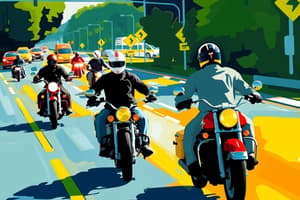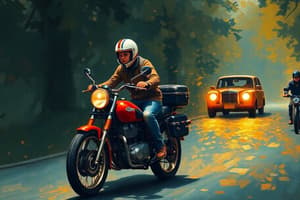Podcast
Questions and Answers
When adjusting mirrors to carry a passenger, the passenger should:
When adjusting mirrors to carry a passenger, the passenger should:
sit on the seat with you
A passenger should:
A passenger should:
hold on to the operator's waist
When the motorcycle is stopped at an intersection, a passenger should:
When the motorcycle is stopped at an intersection, a passenger should:
keep both feet on the foot pegs
When carrying a passenger:
When carrying a passenger:
When riding with passengers, you should:
When riding with passengers, you should:
When carrying loads, you should:
When carrying loads, you should:
A group of riders move from a staggered formation into a single file when:
A group of riders move from a staggered formation into a single file when:
In a staggered formation, the distance should be:
In a staggered formation, the distance should be:
Riders in a staggered formation will be passing a car. After the lead rider passes, he or she should:
Riders in a staggered formation will be passing a car. After the lead rider passes, he or she should:
Alcohol enters the bloodstream and quickly reaches the brain. What is affected first?
Alcohol enters the bloodstream and quickly reaches the brain. What is affected first?
Alcohol first affects your:
Alcohol first affects your:
Approximately half of all motorcycle crash casualties are caused by:
Approximately half of all motorcycle crash casualties are caused by:
If you don't control your drinking:
If you don't control your drinking:
Studies show that almost half of all riders killed in crashes:
Studies show that almost half of all riders killed in crashes:
The ability to think clearly and ride is affected by how many drinks?
The ability to think clearly and ride is affected by how many drinks?
If you drink 4 typical drinks, what is the least amount of alcohol remaining in your body after two hours?
If you drink 4 typical drinks, what is the least amount of alcohol remaining in your body after two hours?
For greatest safety, your helmet should:
For greatest safety, your helmet should:
The single most important thing you can do to enhance surviving a crash is:
The single most important thing you can do to enhance surviving a crash is:
Wearing a helmet can reduce the chance of a fatal head injury in:
Wearing a helmet can reduce the chance of a fatal head injury in:
Wearing a helmet will:
Wearing a helmet will:
Of the following, which one gives the most eye and face protection?
Of the following, which one gives the most eye and face protection?
While riding an unfamiliar motorcycle:
While riding an unfamiliar motorcycle:
The engine cut-off switch is usually located:
The engine cut-off switch is usually located:
With a properly adjusted mirror you can see:
With a properly adjusted mirror you can see:
When slowing for a normal stop:
When slowing for a normal stop:
When turning, you should:
When turning, you should:
Which way do you press and lean during a turn?
Which way do you press and lean during a turn?
While in a turn, it is best to:
While in a turn, it is best to:
If you need to slow down while turning:
If you need to slow down while turning:
To make a normal stop, use:
To make a normal stop, use:
Your motorcycle has two brakes. Use both brakes when:
Your motorcycle has two brakes. Use both brakes when:
In a normal turn:
In a normal turn:
In slow tight turns:
In slow tight turns:
To reduce speed before turning:
To reduce speed before turning:
When turning, it is important to:
When turning, it is important to:
It is important to search the road for escape routes:
It is important to search the road for escape routes:
To make good judgments in traffic, you need to first:
To make good judgments in traffic, you need to first:
The car driver is signaling for a left turn, the rider should:
The car driver is signaling for a left turn, the rider should:
You should make a special point of checking traffic to the rear:
You should make a special point of checking traffic to the rear:
When preparing to pass, it is usually better to:
When preparing to pass, it is usually better to:
Riding in the center lane position:
Riding in the center lane position:
To discourage other drivers from sharing your lane, it is usually best to:
To discourage other drivers from sharing your lane, it is usually best to:
Keeping a cushion of space around your motorcycle:
Keeping a cushion of space around your motorcycle:
To spot approaching traffic and maintain a space cushion in the illustration above, you should:
To spot approaching traffic and maintain a space cushion in the illustration above, you should:
You plan to make a right turn after stopping at an intersection. Usually, it is best to:
You plan to make a right turn after stopping at an intersection. Usually, it is best to:
Following close to vehicles in front of you:
Following close to vehicles in front of you:
When following a car, you should try to ride:
When following a car, you should try to ride:
At intersections, the most common cause of motorcycle/car crashes is:
At intersections, the most common cause of motorcycle/car crashes is:
Car/motorcycle crashes are most common:
Car/motorcycle crashes are most common:
Making eye contact with a driver at an intersection:
Making eye contact with a driver at an intersection:
The greatest danger for a rider when passing parked cars is:
The greatest danger for a rider when passing parked cars is:
In this picture, the light most likely to make the motorcycle noticeable to the car is the:
In this picture, the light most likely to make the motorcycle noticeable to the car is the:
When riding in traffic at night, the best way to locate bumps in the road is to:
When riding in traffic at night, the best way to locate bumps in the road is to:
The best way to help others see your motorcycle is to:
The best way to help others see your motorcycle is to:
Not turning off a turn signal is most likely to:
Not turning off a turn signal is most likely to:
Make a special point to use your mirrors:
Make a special point to use your mirrors:
Before changing lanes to the left, you should:
Before changing lanes to the left, you should:
The best gear to wear at night is:
The best gear to wear at night is:
To see better when following a car at night:
To see better when following a car at night:
When riding at night:
When riding at night:
If you lock the front tire when stopping:
If you lock the front tire when stopping:
When the rear wheel locks when trying to stop quickly:
When the rear wheel locks when trying to stop quickly:
When swerving, it is important to:
When swerving, it is important to:
To ride over metal bridge gratings:
To ride over metal bridge gratings:
To ride over an object in the road:
To ride over an object in the road:
When riding over an obstacle, it is usually best to:
When riding over an obstacle, it is usually best to:
On a paved two-lane road, sand and gravel are most likely to collect:
On a paved two-lane road, sand and gravel are most likely to collect:
On a wet slippery road, it will usually be most slippery:
On a wet slippery road, it will usually be most slippery:
To handle a slippery surface, it is best to:
To handle a slippery surface, it is best to:
To stop on wet pavement:
To stop on wet pavement:
When riding where sand and gravel have collected on paved roads, you should:
When riding where sand and gravel have collected on paved roads, you should:
If the rear tire goes flat:
If the rear tire goes flat:
If you have a flat tire while riding, hold the handle firmly and:
If you have a flat tire while riding, hold the handle firmly and:
When the front tire goes flat while riding:
When the front tire goes flat while riding:
When the front tire goes flat:
When the front tire goes flat:
If your throttle sticks:
If your throttle sticks:
In the picture above, it is best to ride:
In the picture above, it is best to ride:
Most motorcycle/car crashes occur because:
Most motorcycle/car crashes occur because:
To cross tracks that run parallel to your course:
To cross tracks that run parallel to your course:
Flashcards are hidden until you start studying
Study Notes
Motorcycle Passenger Guidelines
- Passengers should sit on the motorcycle seat with the operator.
- A passenger must hold on to the operator's waist for stability.
- At stops, passengers should keep both feet on the foot pegs.
Carrying Passengers and Loads
- Carrying a passenger affects motorcycle acceleration and deceleration time.
- Start to slow down earlier when riding with a passenger.
- When carrying loads, keep them low and as far forward as possible.
Riding Formation and Distance
- Riders should switch from staggered formation to single file when turning corners.
- Maintain a distance of 2 seconds in a staggered formation for safety.
- After the lead rider passes a vehicle, they should return to the left side of the lane.
Effects of Alcohol
- Alcohol impairs judgment, impacting riding ability from the first drink.
- Approximately half of all motorcycle crash casualties involve alcohol impairment.
- Allow at least one hour for every drink consumed before riding.
Helmet Safety
- Wearing a snug helmet significantly enhances crash survival chances.
- Helmets reduce the risk of fatal head injuries in any crash situation.
- Helmets also lower the likelihood of neck and head injuries.
Visibility and Riding at Night
- A faceshield provides the most eye and face protection while riding.
- It is crucial to allow extra stopping distance when riding unfamiliar motorcycles.
- Riding with headlights on improves visibility for other drivers.
Maneuvering and Braking Techniques
- Always use both brakes when slowing or stopping to maximize control.
- During turns, look through the turn in the direction of travel.
- Maintain a consistent speed during turns and be cautious when needing to slow down.
Traffic Awareness and Positioning
- Check mirrors and traffic before slowing, stopping, or changing lanes.
- It is vital to establish a space cushion around the motorcycle to react effectively.
- Special attention should be paid to drivers signaling left turns.
Handling Hazards and Road Conditions
- Slow down before reaching slippery surfaces or obstacles and avoid sudden maneuvers.
- On a wet road, the center lane tends to be the most slippery.
- If a tire goes flat, handle the situation according to the specific tire affected.
General Safety Practices
- Always ride in the center of your lane to maintain lane control.
- Reflective clothing enhances visibility, especially at night.
- Use turn signals correctly to avoid miscommunication with other drivers.
Studying That Suits You
Use AI to generate personalized quizzes and flashcards to suit your learning preferences.




